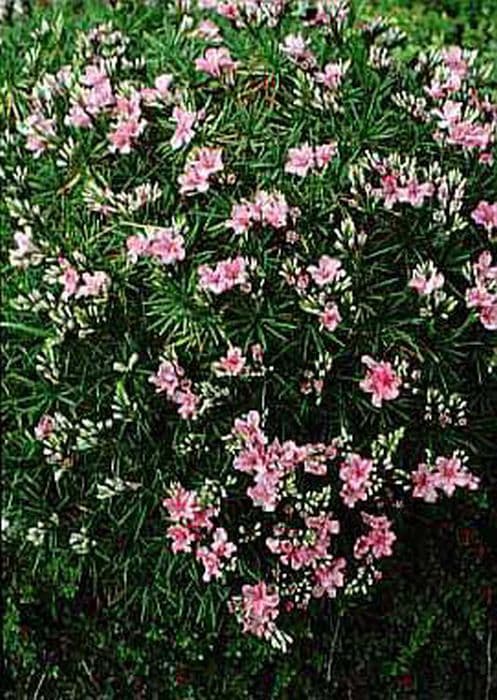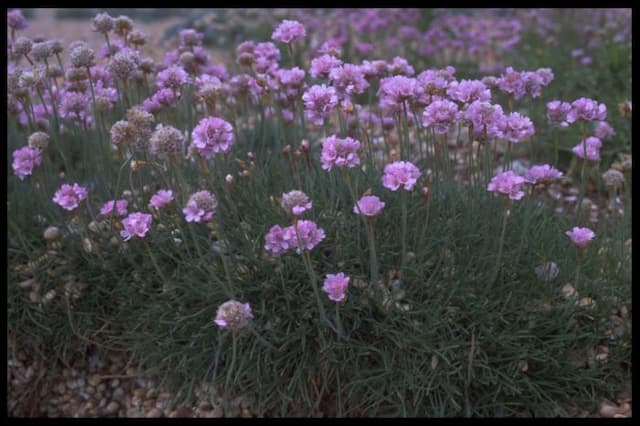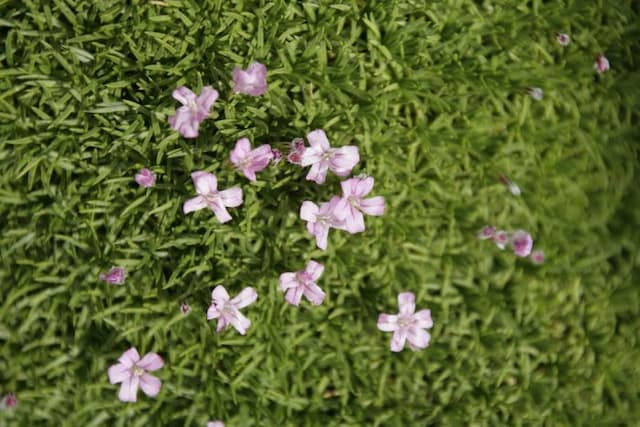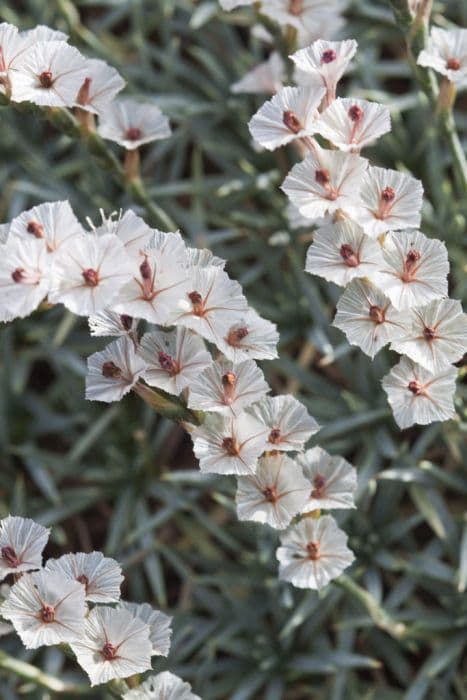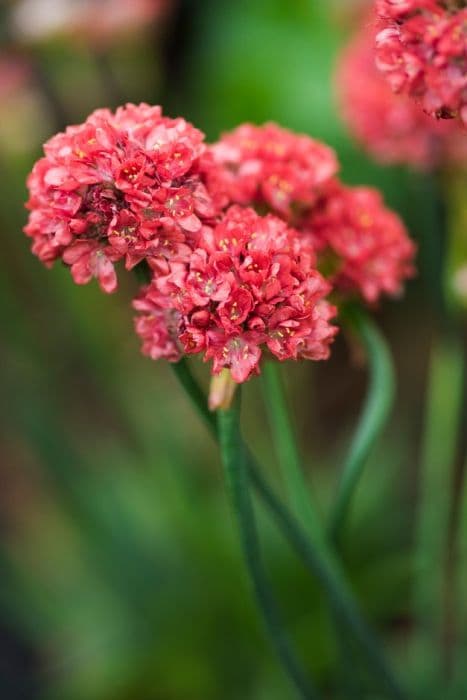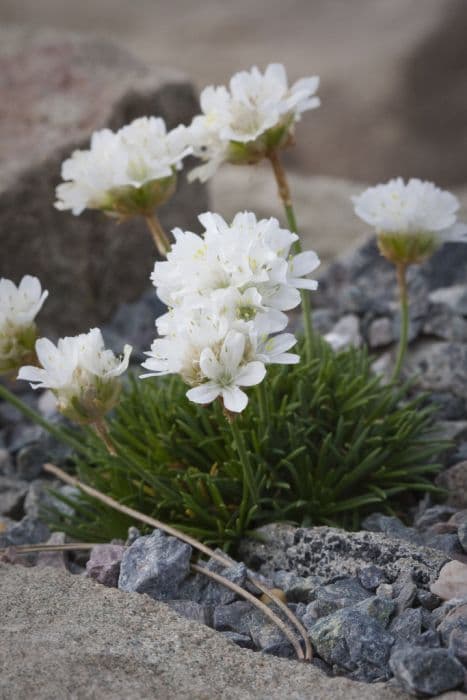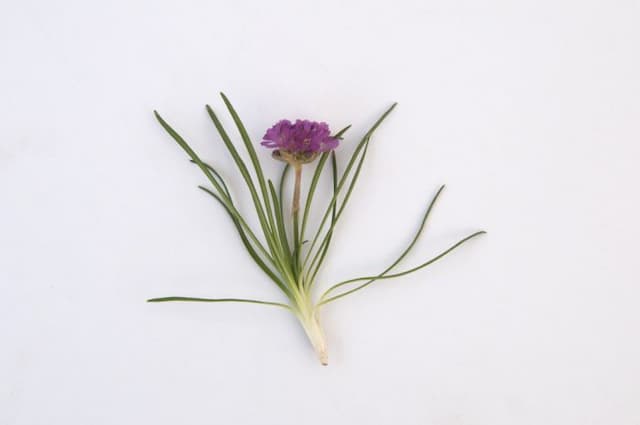Sea thrift Armeria maritima 'Armada Rose' (Armada Series)

ABOUT
The Armada Rose, part of the Armada Series, is an ornamental plant known for its charming, globular pink flowers. These flowers resemble small, round tufts and have a fetching rose-pink hue that adds a splash of color to garden landscapes. The blooms rise proudly above a cushion of grass-like foliage that remains an attractive green year-round. This foliage forms a dense, tufted mound that serves as the perfect backdrop for the vividly colored flowers. The plant is a hardy perennial, contributing to its role as a favorite among gardeners for rock gardens, borders, and ground cover purposes. When in bloom, the Armada Rose provides a striking visual impact with its distinctive, pom-pom-like flowers that seem to float atop the narrow, dark green leaves. Overall, this plant offers a delightful combination of delicate beauty and rugged resilience.
About this plant
 Names
NamesFamily
Plumbaginaceae
Synonyms
Sea Thrift, Sea Pink, Marsh Daisy, Sea Grass
Common names
Armeria maritima 'Armada Rose' (Armada Series).
 Toxicity
ToxicityTo humans
Sea Thrift is generally considered non-toxic to humans. There is no widely recognised toxicity associated with Armeria maritima, and it is not known to cause poisoning upon ingestion. However, as with any plant, individual sensitivities or allergic reactions are possible, so it is advisable to avoid ingesting any part of the plant.
To pets
Sea Thrift is not listed as toxic to pets. The Armeria maritima species, including the Armada Series, is generally considered safe and does not pose a risk of toxicity to dogs, cats, and other domestic animals if ingested. As with all plants, it is still best to discourage pets from eating ornamental plants as a precaution, and individual animals may have sensitivities or allergic reactions to plants that are typically non-toxic.
 Characteristics
CharacteristicsLife cycle
Perennials
Foliage type
Evergreen
Color of leaves
Green
Flower color
Pink
Height
6-12 inches (15-30 cm)
Spread
6-12 inches (15-30 cm)
Plant type
Herb
Hardiness zones
4-8
Native area
Europe
Benefits
 General Benefits
General Benefits- Aesthetic Appeal: Thrives in rock gardens, borders, and containers, adding vibrant pink color and visual interest.
- Drought Tolerance: Once established, it requires minimal watering, making it suitable for dry or xeriscape gardens.
- Low Maintenance: Requires little care beyond occasional trimming to maintain its neat, compact shape.
- Sea Spray Resistance: As a coastal plant, it can withstand salty air and is ideal for seaside gardens.
- Salt Tolerance: Can be planted in areas where de-icing salts might damage other less hardy species.
- Attracts Wildlife: Blossoms attract butterflies and other beneficial pollinators, promoting biodiversity.
- Long Blooming: Offers a lengthy season of blooms from late spring to early summer.
- Cold Hardy: Can survive in colder climates, making it versatile for various garden zones.
- Evergreen: Provides year-round greenery, adding color to the garden even in winter.
- Soil Adaptability: Tolerates a range of soil types, from sandy to loamy, as long as they are well-draining.
- Compact Growth: Its small size makes it an excellent choice for gardens where space is limited.
 Medical Properties
Medical PropertiesThis plant is not used for medical purposes.
 Air-purifying Qualities
Air-purifying QualitiesThis plant is not specifically known for air purifying qualities.
 Other Uses
Other Uses- Armeria maritima 'Armada Rose', commonly known as sea thrift, can be used in model scenery and railroad gardens to mimic small bushes and shrubbery due to its dense, mound-forming growth habit.
- The plant's dense tufts can be used in dry floral arrangements, offering lasting structure and soft color even when the plant has dried out.
- Sea thrift can serve as a natural dye source; the flowers can yield colors ranging from light pinks to deeper rose hues for fabrics and yarns.
- In coastal areas, the salt tolerance of sea thrift makes it suitable for use in living roofs and green roof systems, where it can help in insulation and add aesthetic appeal.
- Because of its low-growing and spreading habit, sea thrift can be used as a living mulch to suppress weeds in garden beds.
- This plant can be planted in crevices of dry walls or rockeries, where it can help stabilize the structure with its roots while providing ornamental value.
- Gardeners can utilize the compact size and evergreen foliage of sea thrift for fairy gardens or miniature landscapes to create a sense of scale and detail.
- Sea thrift's ability to grow in sandy soils can be exploited for sand dune stabilization projects, helping to reduce erosion while adding color and life to the dune ecosystem.
- The cushion-like form of sea thrift is ideal for planting along walkways or edges of patios where it can tolerate occasional foot traffic, exhibiting resilience with minimal damage.
- As a low allergen plant, sea thrift is suitable for gardens designed for people with sensitivities to pollen or other common allergenic plant properties.
Interesting Facts
 Feng Shui
Feng ShuiThe Sea Thrift is not used in Feng Shui practice.
 Zodiac Sign Compitability
Zodiac Sign CompitabilityThe Sea Thrift is not used in astrology practice.
 Plant Symbolism
Plant Symbolism- Strength in Adversity: Armeria maritima, commonly known as Sea Thrift or Sea Pink, typically grows in tough coastal conditions, symbolizing the ability to withstand challenges and remain strong despite difficulties.
- Resilience: Because of its capacity to thrive in rocky soils and high-salinity environments, Sea Thrift represents resilience and the quality of bouncing back from hard situations.
- Long-lasting Affection: With its dense, cushion-like clumps and enduring nature, Sea Thrift is often associated with long-lasting affection and the everlasting nature of love.
- Consistency: The reliable blooming and consistent growth pattern of Sea Thrift is symbolic of consistency and dependability in one's actions and relationships.
- Prosperity: The full, rounded nature of Sea Thrift's blooms can symbolize prosperity and fullness in life, alluding to a sense of abundance and well-being.
- Beauty in Simplicity: The simple beauty of the Sea Thrift's pink flowers reflects an appreciation for simplicity and finding attractiveness in the straightforward aspects of life.
 Water
WaterFor Sea Thrift, water deeply but infrequently to encourage a strong root system. They prefer slightly moist soil, so aim to water when the top inch of soil feels dry, roughly once a week, depending on weather conditions. Use approximately one gallon of water per plant each time you water. During the growing season, keep a consistent watering schedule, and reduce watering in the winter when the plant is dormant.
 Light
LightSea Thrift thrives in full sun conditions where it can receive at least six hours of sunlight daily. It is best positioned in a spot that provides bright, direct light for the majority of the day. Avoid shade as it can lead to poor flowering and a leggy growth habit.
 Temperature
TemperatureSea Thrift is adapted to coastal conditions, tolerating temperatures ranging from around 40°F to 80°F. It can survive brief periods outside this range but thrives when the temperature is moderate. The ideal temperature for Sea Thrift is between 60°F and 75°F, ensuring it is neither too hot nor too cold.
 Pruning
PruningSea Thrift benefits from deadheading spent flowers to encourage additional blooming and maintain a neat appearance. It should be pruned gently, removing dead or dying blooms throughout the flowering season. Pruning is best done in late spring or early summer after the first flush of flowers has faded.
 Cleaning
CleaningAs needed
 Soil
SoilThrift, also known as Sea Pink, prefers well-draining soil with a sandy or rocky composition, ideally mixed with organic matter. Best soil pH for Thrift is slightly acidic to neutral, around 5.5 to 7.5. A mixture of coarse sand, peat, and loam in equal parts can create an ideal growing medium for this plant.
 Repotting
RepottingThrift, commonly known as Sea Pink, generally does not require frequent repotting and can be done every 2-3 years. Ensure that each new pot has adequate drainage and is slightly larger than the previous one.
 Humidity & Misting
Humidity & MistingSea Pink, the common name for Thrift, is tolerant of a wide range of humidity levels and thrives in outdoor conditions where there is natural air circulation. It does not require any special humidity adjustments, making it ideal for typical garden settings.
 Suitable locations
Suitable locationsIndoor
Place Thrift in a bright spot & ensure well-draining soil.
Outdoor
Plant Thrift in full sun with well-draining soil.
Hardiness zone
4-8 USDA
 Life cycle
Life cycleArmeria maritima 'Armada Rose', commonly known as Sea Thrift or Sea Pink, begins its life as a seed which germinates in early spring, given the right conditions of light and temperature. Once sprouted, the seedling emerges with narrow, grass-like leaves and grows into a compact, evergreen, tufted perennial. During late spring to early summer, it produces dense, globe-shaped pink flower heads atop leafless stems that rise from the foliage mound. After blooming, if pollination occurs, the flowers will produce seeds ensuring the next generation. The plant then enters a period of dormancy in winter, where growth slows down significantly due to colder temperatures and shorter days. In subsequent years, Sea Thrift continues to grow and bloom annually, slowly expanding in clump size, until it reaches its lifespan limit, after which the plant will die, leaving seeds as its legacy for future growth.
 Propogation
PropogationPropogation time
Spring to early summer
The most popular method of propagation for the Sea Thrift (Armeria maritima 'Armada Rose') is by division. This is typically done in the spring or early fall when the plant is not in active bloom. To propagate through division, carefully dig up the clump of Sea Thrift, ensuring to preserve as much of the root system as possible. Using a sharp knife or spade, divide the clump into smaller sections, each with a portion of the roots and several shoots. Replant these sections at the same depth they were growing before and water them well. This encourages the development of a strong root system in each new plant. After replanting, maintain consistent moisture and protect the new plants from extreme weather to ensure successful establishment.
